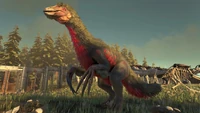Mutations are a breeding-mechanic that can alter the stats or the color of a bred offspring.
Probability
The probability for at least one mutation in an offspring is around 7.4%, for two mutations around 0.18% and for three mutations around 0.000016 %.[1] Each mutation affects both a stat and a color, whereas the color-mutation cannot always be recognized.
For each offspring there are three possible stat-mutations which can happen on the same stat multiple times. Each one of the three possible mutation has a chance of 2.5% to happen.
Effects
Stats
Currently there are only positive effects on the stats: a mutated stat is 2 levels higher than the inherited from the parent. Any inherited stat can mutate even "bad" stats inherited from the parent with the lower value in a particular stat.
A bred creature can have a maximum of twenty paternal plus twenty maternal mutations before random mutation will no longer occur in offspring. The total number of mutations is inherited from the respective parent even when the mutated stat or color is not selected when the baby's stats are generated.
Due to the limited nature of mutations (20/20) and to maximize the gain from them it's important how the mutated creatures are included the breeding-line. Any baby that did not inherit one or more of its parents' mutations has limited value in further breeding. Mutations should ideally occur on already high base stats because of the high time investment in breeding for mutations and the chance of finding a wild creature with better base stats that could achieve higher numbers. It is best to keep separate breeding-lines for each mutated stat and to breed them together when happy with the resulting stats. Once a creature has a 20/20 mutation-counter, no more mutations can happen to its stats.
Colors
Mutated colorations can be that of any color pallet including the species own originally available colors. Red, green, blue, yellow, cyan, and magenta color mutations are highly sought after. Many breeders will try to eradicate any color mutations from the gene pool to prevent the undesired color from being passed on through the gene pool



